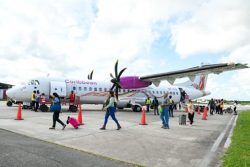It now appears that hassar from the infamous Tobago Hill, Northwest project escaped to freedom through “damaged water pathways” in the ponds.
This is the version that is now being related by Minister of Agriculture, Dr Leslie Ramsammy following a visit to Tobago Hill as part of his ministry’s outreach on behalf of the government’s National Secure Livelihoods Pro-gramme (NSLP).
In March of this year, Amerindian Affairs Minister Pauline Sukhai had declared that the Tobago Hill hassar rearing project was a success and had complimented the residents for their caring of fingerlings. She said that residents were about to harvest the first set of hassar.
However, when Stabroek News visited the area later that month, there was no sign of hassar. The ponds were overgrown with weeds and the then village toshao said he was unsure about the future of the project. He said that residents would shortly begin to clear the weeds.
The Ministry then offered various explanations for the variance between the minister’s utterances and the situation on the ground. Santiago was later replaced as toshao but not before posing for the Government Information Agency with a hassar reputedly from the Tobago Hill pond.
In a statement on September 3rd following a visit by Ramsammy to the area, GINA said Tobago, as part of the Secure Livelihood Programme, had established an aquaculture farm in the community but there were some challenges with fingerlings.

“At the beginning of the project the residents were working with a VSO (Voluntary Service Organiza-tion volunteer) and attempts were made to place 10,000 fingerlings in the pond but the majority of these had escaped through damaged water pathways in the ponds”, it reported.
It was the first such explanation given for the missing hassar.
GINA went on to say that residents, however, have expressed interest in continuing the project while the minister pledged that he would arrange for personnel from his ministry and an aquaculture expert to work with the residents.
The release said that the Amerindian Affairs Ministry also plans in the dry season to bring some of the local farmers to town so as to acquire some fingerlings.
GINA said that Ramsammy and a team of officials recently visited the communities of White Water, Wauna, and Tobago, communities in which the National Secure Livelihood Pro-gramme (NSLP) was initiated and held discussions with the residents.
It said that the NSLP is aimed at transforming the economies of Amerindian villages and hinterland communities through economic diversification and the project remains a priority of the administration.
White Water
White Water under the programme had ventured into pineapple cultivation and has found a market for its produce in Amazon Caribbean Guyana Limited. One specification of the purchase, however, is that the pineapple must first be certified and verified as organic.
GINA said that the residents were also encouraged to grow more pineapples to meet the demand from the buyer who has had some difficulties getting the required minimum of 1000 pineapples in one batch for processing.
Wauna
In Wauna, a group of 15 women would like to open a bakery in the village, a new venture for the villagers, GINA said.
The women have acquired the land for the construction of the bakery and plan to begin operations early next year.
Ramsammy pledged the ministry’s support to the project, GINA said.
The NSLP is a Ministry of Amerindian Affairs venture that was launched in June 2009, following Cabinet’s approval and it was piloted in 15 communities in Region One.
Agricultural ventures such as aquaculture, crab rearing and the cultivation of pineapples and passion fruit were executed in the communities and the Amerindian Affairs Ministry employed the services of VSO specialists to guide and support the local farmers in commencing their operations, GINA added.





